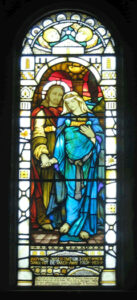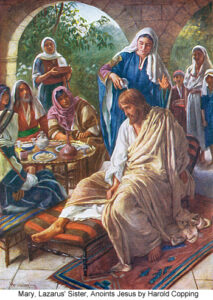How to Return Goddess to Judeo-Christianity
“I would like to ask how to return the Divine Feminine to Judeo-Christian religion. My background is Christian, but I find that traditional church is missing something. I feel maybe your organization may help me grow spiritually.” — Stuart, Alberta Canada
We received this inquiry the other day via our northernway.org website. I thought some of you might wish to offer Stuart some ideas, advice, point him in the direction of resources you know, etc.
Margaret Starbird answered:

Maybe Stuart could start by reading the Mary Magdalene page on your northernway.org website. That page introduces him to the “Lost Bride†who was once at the heart of the Christian story. Tell him that the first heresy in Christianity was the denial of the Bride….and that in silencing her, the Church fathers silenced women’s voices on the planet for nearly two millennia! Now, in the Year of Our Lord MMxv, we celebrate her return to our consciousness bringing wisdom, compassion, and celebration of life and the gift of our bodies as “vesselsâ€â€”containers for the Spirit of God. Show him the “marriage window†from Dervaig, Scotland, where Jesus and Mary are “hand-fasted†(clasping right hands, as in the rites of Christian marriage)…. and if he wants more, send him to my website: http://www.margaretstarbird.net
In memory of Her—
Margaret
“The Woman with the Alabaster Jar”
* * * * * * * * * * * * * * * * *
Mystic and poet Wynn Manners said in our GoddessChristians forum:
The First Step, of course, is bringing the Divine Feminine into your own daily life and daily devotions.
Returning the Divine Feminine to Judeo-Christian religion as a whole, is a tall order… and it’s just gonna take a lonnng time… and I’m meaning at least centuries.
What Yeshua once told me was, “Goddess must be elevated for a thousand years.”
He also once indicated that Goddess has to have a different language than the patriarchal religious language.
In Her Spirit we must bring forth different words, a different conceptual matrix rather than just copping-out on Her by carbon-copying the patriarchal language describing the patriarchal God and transferring that to Her.
The Second Step is that we have to be in genuine comm*union* with Her Holy Spirit… so that we are receiving Her Direct Guidance… for She’s the One who will know how to bring about the needed changes.. . She’s the One who can provide us with the phraseology of a variant linguistic and conceptual paradigm. We have to become extensions of Her Living Spirit, womanifestations of Her transformative Spiritual Essence into time. We have to become Her Living Hands, Her Heart & Mind & Spirit — rising like waves of Her Eternal Ocean of Spirit into this time.
The Divine Feminine in Christianity, at this point in time, is mainly represented by Sophia, Mother Mary and Mary Magdalene.
Margaret Starbird’s books on Mary Magdalene are an important resource… relative to the Divine Feminine Bride of Yeshua Christ.
There is some measure of Marian worship in Roman Catholicism… but it’s highly doubtful that it’ll ever be “legitimatized” by the patriarchal stranglehold over that denomination.
When talking about Judaism and Christianity, the most helpful book by way of a Major Resource (that I’m aware of) relative to the Sophia of the Bible is WISDOM’S FEAST: Sophia in Study and Celebration by Susan Cole, Marian Ronan and Hal Taussig. Two of these have been in the Methodist ministry; one is Roman Catholic in background.
Of course you’re gonna get a lot of flack from conservative Christianity… so those seeking to help return the Divine Feminine to Judeo-Christian religion need to be well-versed in all the segments in the Bible that reinforce the Divine Feminine perspective and Sophia (as the Holy Spirit) specifically. Tho they won’t be of any use to you, relative to conservative theological lock-ins, it is also best to be well-versed in all parts of the ancient Gnostic scriptures that reveal more about Sophia & the Divine Feminine in general.
For example, it is very important to realize that when Yeshua spoke of what we have translated into the English words “the Holy Spirit” that he was always referring to Her with feminine pronouns, not the masculine pronoun as is falsely translated in the Gospel of John, chapters 14 & 16. The Hebrew word for spirit is ruach… and the Aramaic word for spirit is rukha (there are variant English spellings of these two words)… both of which are feminine nouns. I think it is also important to know that in “The Gospel of the Hebrews” Jesus actually called the Holy Spirit his Mother! Jerome — who, to my understanding, translated the entire Bible (including the intertestamentary books — which Protestantism expurgated from their Bibles — thus deleting major revelations about Sophia — “Sirach” chapter 24 and “The Wisdom of Solomon”) into the Latin Vulgate also considered “The Gospel of the Hebrews” sufficiently spiritually legitimate that he translated it too! Roman Catholicism did not include “The Gospel of the Hebrews” in their canon — and only quotations from it have survived in some of the Church Fathers’ writings… but maybe a complete copy if it will eventually be discovered and we’ll be able to determine why it was excluded from the canonized scriptures — and (possibly) learn much more therefrom relative to early Christian beliefs and actual further teachings of Yeshua that didn’t survive otherwise.
In the Nag Hammadi Library, works like “The Gospel of Philip”… “Thunder, Perfect Mind”… “Trimorphic Protennoia”… and “The Apocryphon of John” (and others like “The Hypostasis of the Archons” and “Upon The Origin Of The World”) are important resources relative to awareness of Sophia & the Divine Feminine as it existed in the early centuries of Christianity… and the return of neo-Gnostic denominations of Christianity, as they florish across centuries ahead will surely be utilizing these… along with more contemporary revelations of and from the Divine Feminine… for, of course, we’re going to get lots of future texts being written across the centuries forthcoming by many who are “in Her Spirit”.
It’s going to be exciting!
Besides contemporary Gnostic groups (like those of Tau Malachi and Tau Rosamonde Miller) incorporating the Divine Feminine in their services, there are a few contemporary ministers in the mainline Christian denominations who are devoted to the Divine Feminine, too. Foremost, to my knowledge, is “herchurch” (ECLA Lutheran) in San Francisco, California.
https://www.facebook.com/pages/herchurch/135493109832761
I think it also Of Value to read some of what the opposition to the Divine Feminine are writing… so that one is aware of what kind of criticisms / attacks one needs to be equipped to respond to for the sake of the borderline sorts (one is hardly going to convince the “hardliners”).
http://www.exposingtheelca.com/exposed-blog/category/goddess%20worship
The only major Christian denomination (that I’m aware of) which recognizes Goddess, is Mormonism — but you’ll hardly find that out from the most of what they’re saying! — for they pretty much “keep Her in the closet”… and (it appears to me) that the voices of the women who want to promote Her are being suppressed by the Mormon patriarchy. One writing friend (who is Mormon) at a local writers group a half a dozen years ago, when I asked him about it, said that Mormons don’t broadcast Her Existence because She’s too holy to them to beget circumstances where unbelievers will be profaning Her. Another Mormon who came to my door about six months ago — when I brought up the subject to him — said that Mormons are condemned to hell for so many of their doctrines, already, that they didn’t want to be adding more fuel to the fires of other denominations condemning them as not being Christians by publicly advocating Goddess, too — for of course that gets labelled as being “paganism” by Christians who condemn the Divine Feminine.
I praise those who are working within the established denominations, trying to “return the Divine Feminine to Judeo-Christian religion” — but, overall, I believe it’s going to turn out to be a heart-breakingly futile attempt. (I’ll be only happy to be proven mistaken in this assessment! I believe there are several in the ministry who would love to incorporate Her in their services, but are very well aware that they will either lose their positions… or lose most of their congregation — especially the conservative ones who make the larger monetary donations.)
I think, in largest part, those capable of doing so are just going to have to start up their own separate denominations… just like Methodism, Lutheranism, Christian Science, Seventh Day Adventists, Mormonism, Unity & the Jehovah Witnesses all had their own beginnings (or, more anciently, Valentinism, the Sethians, the Barbelites, etc. did) — only these new denominations will totally incorporate the Divine Feminine, eliminating the distortions and still-faulty mythology of many of the ancient Christian Gnostic sects. And they will be bringing forth “The New Wine of Her Spirit”.
~~wynn manners
http://cosmicwind.net/800/Cmwl/SiteMap/CmwlSiteMap.html
https://www.facebook.com/pages/Sophia-Mother-of-the-All/332599176773679
https://www.facebook.com/pages/Seeking-Mary-Magdalene/102467599878534
* * * * * * * * * * * * * * * *
I personally have had good experience with the Unity Church, a very metaphysical Christian denomination. They allow Goddess to be mentioned in childrens’ Sunday School — She is not suppressed! Unity Churches are in most cities. Â — Katia
* * * * * * * * * * * * * * *
Margaret Starbird wrote yesterday regarding this article about about Mary Magdalene’s similarities with the Egyptian Goddess Isis.
https://www.academia.edu/12129204/Tears_and_Fragrance_for_the_God_s_Death_and_Resurrection_The_Funerary_Syncretism_of_Mary_Magdalene_with_Isis
Margaret says: Although this author, Dr. Margaret Merisante, does not site my work, she could have. I discussed the connection of Mary Magdalene with Isis, the original “Sister-Bride†of a sacrificed Bridegroom-King in my Woman with the Alabaster Jar (published in 1993). I’m not an expert on Egyptian funerary rites, but I recognized the connection of the anointing of the king as an ancient rite from the Hieros games cult in which the marriage union of the “Beloveds†is followed later in the liturgical season by the assault, mutilation, death and burial. This connection of Mary Magdalene with Isis is strong—based on the “Song of Songs†where the fragrance of the “Sister-Bride†spreads around her Bridegroom at the banqueting table. The “Canticle†(Song of Songs) is known to be a a liturgical poem from the cult of Isis and Osiris. The Bridegroom speaks of his beloved as “My sister, my spouseâ€â€” which I believe was the epithet given to the wives of Jesus and his apostles, the “sister-wives†Paul mentions in his letter to Corinthians (1: 9-5).
I’m so thrilled that others are finally seeing this connection and are willing to research and affirm that Mary Magdalene is indeed, the “Goddess in the Gospels“.
In memory of Her—
Margaret
“The Woman with the Alabaster Jar”
www.margaretstarbird.net

